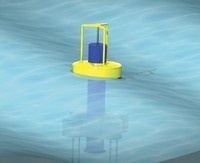Swell development
A wave-energy technology developed by Ocean Navitas is designed to generate power in 3.5m sea states.
It was while sailing in the Caribbean that James McCague, technical director of Ocean Navitas, hit upon the idea of developing a new type of wave-energy device.
Returning to the UK, McCague conducted a review of existing wave-energy-conversion devices before concluding that his method of extracting electrical energy from the waves would provide genuine advantages over existing systems. The result of his efforts is a renewable-energy system that will generate power at its maximum rated capacity in sea states of 3.5m in coastal regions around the UK.
In the Ocean Navitas system, a buoyancy float is carried up and down as it reacts to ocean swell and the effect of gravity. The motion of the float is then transferred through a set of bespoke gearing to a standard permanent magnet alternator that creates electrical power.

At the heart of the system is the Aegir dynamo mechanical drive. This is responsible for converting the energy captured from the upward motion of the waves and the downward motion of gravity into singular directional rotational energy.
Register now to continue reading
Thanks for visiting The Engineer. You’ve now reached your monthly limit of premium content. Register for free to unlock unlimited access to all of our premium content, as well as the latest technology news, industry opinion and special reports.
Benefits of registering
-
In-depth insights and coverage of key emerging trends
-
Unrestricted access to special reports throughout the year
-
Daily technology news delivered straight to your inbox










Water Sector Talent Exodus Could Cripple The Sector
Maybe if things are essential for the running of a country and we want to pay a fair price we should be running these utilities on a not for profit...